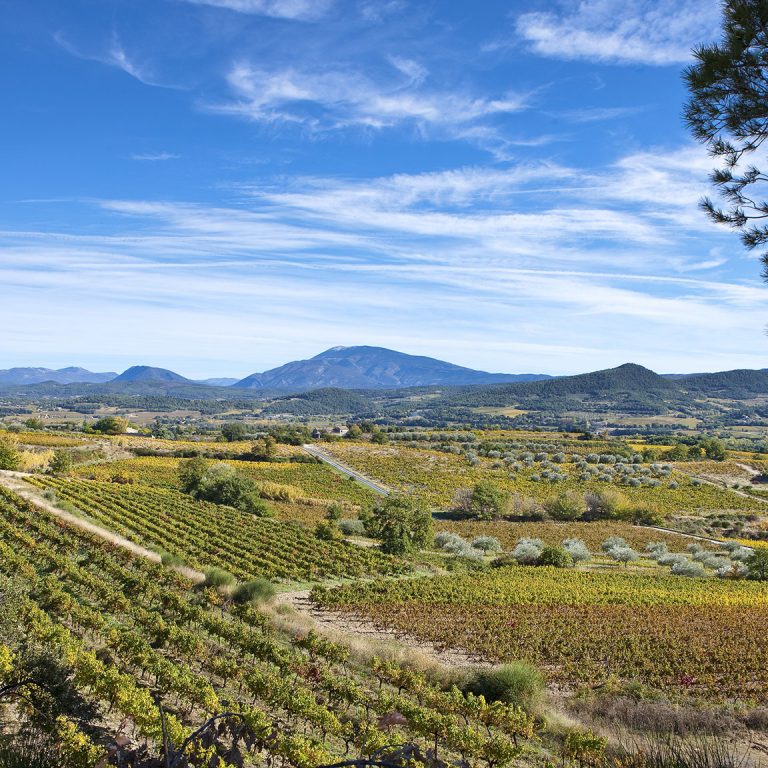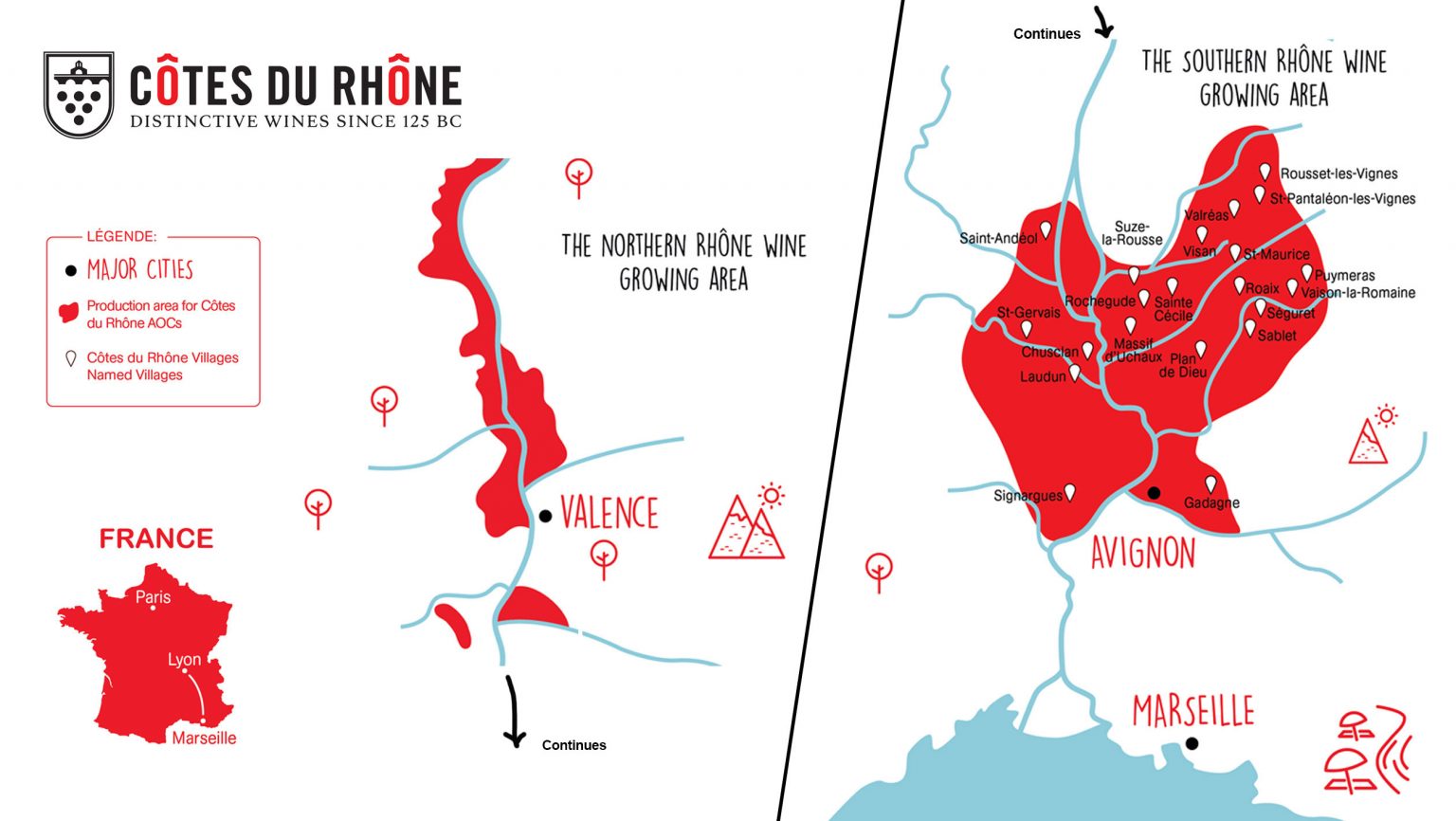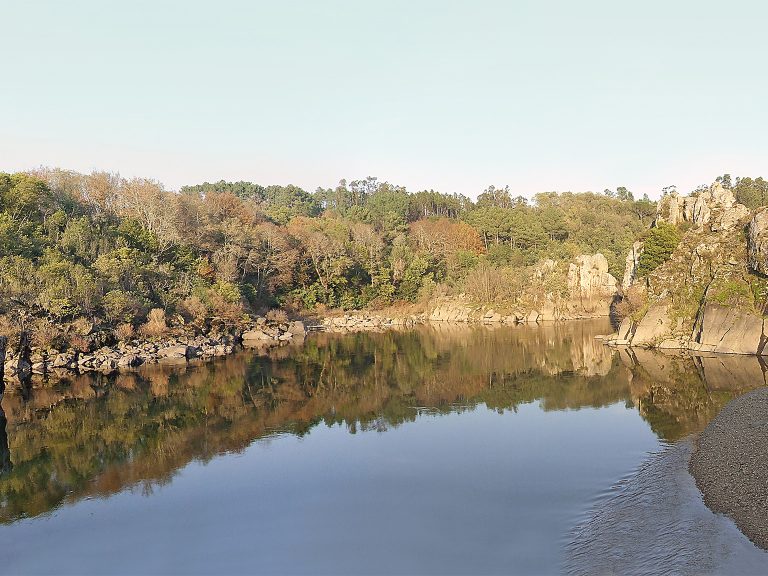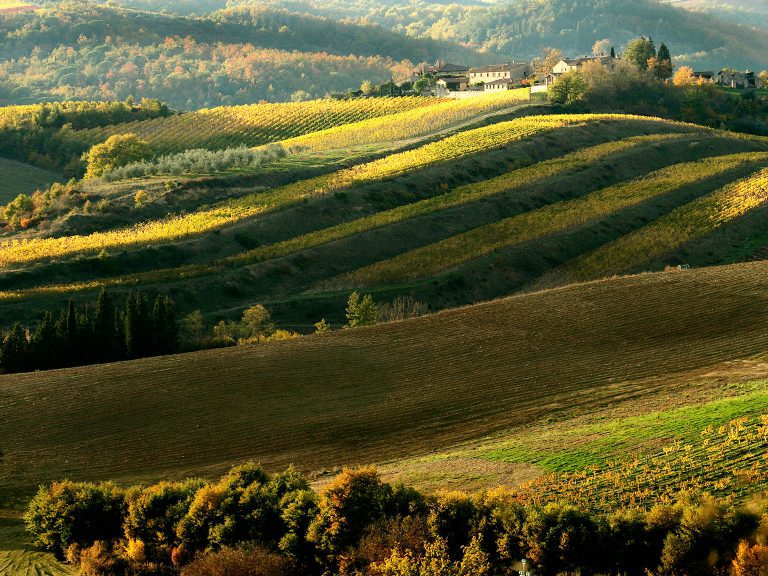This advertising content was produced in collaboration with our partner, Côtes du Rhône.
Although the Rhône Valley has garnered plenty of attention in the 21st century, the spotlight has mostly focused on the region’s prestigious crus. However, the backbone of the Rhône Valley is the Côtes du Rhône, a geologically diverse area that covers 30,000 hectares throughout the northern and southern Rhône and produces most of the region’s wines.
The area has a long and storied history that’s centered around the city of Avignon, which is considered to be the capital of the Côtes du Rhône. When the ancient Romans first established the city, they planted vines, and it was in Avignon that Pope Clement V—the namesake of Châteauneuf-du-Pape—relocated his court and planted a papal vineyard.
Despite this long heritage of quality winemaking, many of the Côtes du Rhône’s finest gems remain relatively unknown. The Côtes du Rhône Villages AOC offers distinctive terroir expressiveness and quality at exceptional values, particularly within the tier of 21 villages that may append their names to the Côtes du Rhône Villages moniker. And given the wide range of mesoclimates, soils, and grape varieties that fall within the broader Côtes du Rhône region, the wines produced here are exceptionally diverse, making them fit for a wide variety of food pairings and palate preferences.

Don’t miss the latest drinks industry news and insights. Sign up for our award-winning newsletters and get insider intel, resources, and trends delivered to your inbox every week.
The Côtes du Rhône may seem like a known entity, but it has plenty of surprises in store for American buyers and consumers alike.
Geography
The Côtes du Rhône appellation covers much of the Rhône Valley, following the Rhône River from Vienne in the north past Avignon in the south and encompassing 171 different villages. Therefore, the region’s geography is exceptionally diverse, ranging from steep slopes to rolling hillsides.
Though the Côtes du Rhône AOC covers vineyards in both northern and southern Rhône, much of the production is concentrated in the south, with Avignon considered as its capital. Here, the Mediterranean climate creates hot, dry summers and mild, wet winters. During the growing season, rainfall is notoriously scarce, and the sun is abundant, supplying more than 2,800 hours of sunshine a year. Vines must contend with the fierce, northerly Mistral wind, but they also benefit from the Mistral’s drying effect, which lowers disease pressure and allows healthy grapes to ripen fully in the Rhône sun.
The region is also home to a mosaic of varied soil types, each of which results in a unique style of Côtes du Rhône wine. While the famous galets of the southern Rhône create powerful, age-worthy wines, sandy soils yield wines with elegance, delicacy, and freshness. Limestone soils tend toward round and aromatic wines, while clay often produces rich, full-flavored wines. This terroir diversity is a key component of the variety found within Côtes du Rhône wines.
History
The Côtes du Rhône AOC was established more than 80 years ago, but that’s a blink of an eye compared to the region’s winemaking heritage. More than 2,000 years ago, the Greeks and then the Romans colonized the area, bringing their wine traditions to the region now known as the Rhône Valley. As early as 125 B.C., the Romans established the city of Vienne and created terraces on the surrounding land, planting vines to protect them. Other cities—and their surrounding vineyards—were founded soon after.
Even after the fall of the Roman Empire, winemaking continued in the Rhône Valley over the following centuries. In 1309, Pope Clement V relocated the papacy to Avignon and planted papal vineyards, which successive popes expanded and championed. This served to raise both the quality and awareness of the wines, which would later be named Côtes du Rhône. When the papacy moved back to Rome in 1378, wines continued to be shipped to the Papal court in Italy.
In the 17th and 18th centuries, Côtes du Rhône wines were sold readily to both French and British consumers. The first regulations to ensure the authenticity and quality of these wines were introduced in 1650, followed by a 1737 royal decree that required all barrels to be designated with the letters “C.D.R.”
Although the southern Rhône was one of the first French regions hit by phylloxera in the 19th century, vintners replanted and in 1937, Côtes du Rhône became one of the country’s first AOCs, cementing the region’s quality reputation. The Côtes du Rhône Villages AOC followed 30 years later, in 1967.
Key Appellations
The Côtes du Rhône region is home to three main quality tiers within two AOCs, all of which may produce red, white, and rosé wines.
Côtes du Rhône AOC
The Côtes du Rhône AOC forms the base of the Côtes du Rhône quality pyramid, producing 48 percent of the Rhône Valley’s wine. It covers 171 villages in both northern and southern Rhône. As a result, AOC wines are quite varied. Red wine comprises 84 percent of production, while rosé and white wine make up 10 and six percent of production, respectively.
Côtes du Rhône Villages AOC
The Côtes du Rhône Villages AOC is the next tier up from Côtes du Rhône AOC. It showcases villages that have proven their wines to have exceptional quality and character. Ninety-five villages located in the area around Avignon and Orange may label their wines as Côtes du Rhône Villages.
While this AOC recognizes the quality that these villages lend to their wines, it also allows the wines to benefit from the recognition that the Côtes du Rhône name provides. “It takes time to make a name,” says Daphné Payan, an account manager for Inter-Rhône. “Remaining in the Côtes du Rhône is a way to keep that collective identity. For people who are not in the wine industry, there’s more of a chance they know Côtes du Rhône than the village name by itself.”
The vast majority of Côtes du Rhône Villages production is red, with three percent white wine and just one percent rosé. Overall, the AOC comprises 12 percent of the Rhône Valley’s wine production.
Côtes du Rhône Villages with Geographical Names
Located across alluvial plains and hilly slopes, a select 21 geographical names may append their names to the Côtes du Rhône Villages label. Some are the names of villages themselves, while others are adopted geographical names across an area that might include several communes. The 21 geographical names are: Chusclan, Gadagne, Laudun, Massif d’Uchaux, Plan de Dieu, Puyméras, Roaix, Rochegude, Rousset-les-Vignes, Sablet, Saint-Andéol, Saint-Gervais, Saint-Maurice, Saint-Pantaléon-les-Vignes, Sainte-Cécile, Séguret, Signargues, Suze-la-Rousse, Vaison-la-Romaine, Valréas, and Visan.
“Do not be afraid of the pronunciation of some of these villages!” Payan says jokingly. Of the 21 geographical names, only a handful, including Sablet, Séguret, Visan, Valréas, Laudun, Chusclan, and Plan de Dieu, are imported to the U.S. Exploring these unique “villages” is an excellent way for buyers to introduce consumers to a new discovery without taking them too far outside their comfort zone.
“Let’s not forget that many of the crus were once Côtes du Rhône Villages,” says Eileen Fabunan, an account manager for Inter-Rhône. “It’s a great opportunity to taste that upper-middle tier.” Most Côtes du Rhône Villages wines—with or without a village name appended—sell for $10 to $25, an excellent value. With stricter production standards and lower yields, Côtes du Rhône Villages with geographical names wines are typically truer expressions of their terroir and can age for five to 10 years.
Key Grape Varieties
Twenty-three different grape varieties are authorized to produce the red, white, and rosé wines of Côtes du Rhône, so it’s no surprise that this is a region of blends. Not only does this expand the variety of versatile and food-friendly styles produced within the Côtes du Rhône and Côtes du Rhône Villages AOCs, but it also allows vintners to express their own winemaking styles.
The Côtes du Rhône’s grape-blending tradition has been honed over decades, and many winemakers have learned their craft from generations of knowledge passed down through family. “Across the board, most of the winemakers are the owners, so that tradition is very strong here,” says Fabunan. “It’s very hands-on and staying strong in the next generation as well.”
Côtes du Rhône has long been known for its red wines, which comprise the majority of the region’s production, particularly its world-famous Grenache-Syrah-Mourvèdre (GSM) blends. Recently, though, white wines have been rising in prominence. Winemakers have been replanting vineyards to white varieties, seeing both quality potential and demand for Côtes du Rhône Blancs. However, they’re carefully researching the best areas within the region for white grapes. “Many of those winemakers have become a lot more vigilant about selecting their terroir,” says Fabunan. “They know they want to invest in planting in the right places because they can see the potential in it.”
Although the style of Côtes du Rhône Blancs varies, most of these wines combine fresh aromas and flavors with weight and richness. “Freshness has been a big focus,” says Payan. “The whites really highlight the freshness and aromatics, but you still get richness on the palate.”
Winemakers have also placed new emphasis on their rosé wines, crafting them intentionally while differentiating them from the pale Provençal rosés to the south. Rather than mimicking other rosé styles, Côtes du Rhône rosés are rounder, fuller-bodied, and designed to be paired with food. “Most of the producers are proud of the fact that these are Grenache-Syrah rosés, and the color is a bit deeper,” says Fabunan.
Across all styles, principal varieties must comprise between 70 and 80 percent of the wine’s cépage, depending on AOC.
Key Red Varieties
Grenache
The cornerstone of Côtes du Rhône wines, Grenache is exceptionally well-suited to the region’s hot, sunny, dry conditions. It’s a vigorous and adaptable grape, providing ripe fruit flavors, full body, and high alcohol to blends, along with distinctive notes of herbs and spice. It originally hails from Spain, but it has undoubtedly found a home in the Rhône Valley.
Mourvèdre
After years of being considered as a “secondary” variety, Mourvèdre is valued for its ability to thrive in warm, sunny conditions and produce deeply colored, full-bodied, tannic wines. This hardy vine is able to withstand strong winds, and it produces intriguing red and rosé wines.
Syrah
The key grape of the crus of the northern Rhône, Syrah also plays an important role in Côtes du Rhône wines. It adds elegance, structure, and acidity, as well as black fruit, floral notes, and plenty of spice, to blends. And, of course, Syrah only becomes more complex as it ages.
Carignan
Carignan isn’t a principal variety of the Côtes du Rhône, but vintners have increasingly embraced it for its good yields amid strong wind, low rainfall, and warmth. Carbonic maceration is often used to extract flavor, as the grape can have intense tannins.
Cinsault
Although Cinsault isn’t a principal variety for Côtes du Rhône wines, it’s valued for its hardiness and reliable yields. With fresh fruit and low acidity, Cinsault is often used for youthful reds and rosés.
Key White Varieties
Grenache Blanc
The white-berried form of Grenache Noir, Grenache Blanc is a staple of Côtes du Rhône Blancs wines due to its drought resistance. It’s usually blended to create generous, elegant, fruity wines.
Clairette
An old Mediterranean grape, Clairette creates rich, high-alcohol wines with fruity notes. It works best when it’s blended into youthful wines.
Marsanne
Marsanne prefers warm, stony soils and produces full-bodied, moderate-acidity wines. It’s often blended with more aromatic varieties, but notes of flowers and hazelnut will develop during aging.
Roussanne
Typically blended in the Côtes du Rhône, Roussanne makes complex and elegant wines with delicate aromas that develop over time.
Viognier
More prominent in the northern Rhône, Viognier produces round and unctuous wines with prominent aromas of ripe fruit, fragrant flowers, and spices.
Bourboulenc
This late-ripening grape variety is hardy in the vineyard, making it a useful tool in Côtes du Rhône blends. It produces crisp, fresh, floral wines.
What’s Happening in Côtes du Rhône Today?
As new generations of winemakers enter wineries, the Côtes du Rhône has experienced a revival. “There is a very strong trend with sustainable and organic winemaking,” says Payan. “Many younger winemakers are transitioning to organic winemaking.” Due to the region’s sunny, dry climate, it’s well-suited to organic practices; for instance, the dry Mistral keeps grapes healthy without the use of fungicides.
Of course, focusing on sustainability goes hand in hand with managing climate change—a key hurdle in a region that’s already hot. Some winemakers are working to preserve freshness by harvesting at night and keeping grapes in cold rooms. Because there isn’t enough water to irrigate the many vines of the Côtes du Rhône, vintners are looking for ways to reduce the need for irrigation.
Interestingly, Côtes du Rhône winemakers may find answers for future longevity in lessons from the past. Many vintners are returning to the traditional varieties of the southern Rhône, which have already proven that they thrive in Côtes du Rhône’s hot, dry conditions. Some are turning away from Syrah, which needs more water when it’s planted in the south, and focusing on such grapes as Grenache, Mourvèdre, Cinsault, and Carignan.
Of course, vintners today have the advantage of using technology when it comes to finding the optimal varieties for each site. “They are very technical when it comes to which varieties they are planting,” says Payan, adding that Inter-Rhône has been supporting the research and analysis of specific sites as well. As winemakers take a collaborative approach to future investment, they also ensure that the quality of Côtes du Rhône will last in the years to come.










